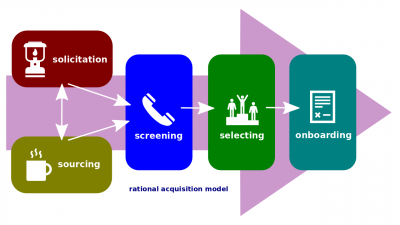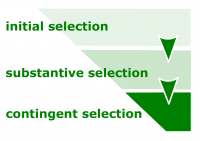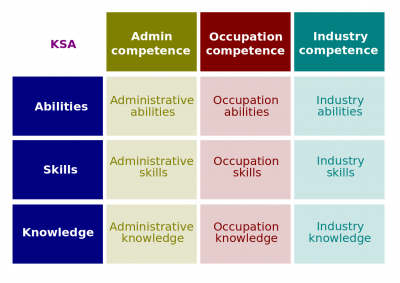Difference between revisions of "Book of Recruitment"
(→Services of recruiters) |
(→Services of recruiters) |
||
| Line 33: | Line 33: | ||
===Services of recruiters=== | ===Services of recruiters=== | ||
:'''[[Recruitment service]]'''. Any service related to [[recruitment]].<div style="background-color:#efefef; padding: 5px; margin: 15px;"> | :'''[[Recruitment service]]'''. Any service related to [[recruitment]].<div style="background-color:#efefef; padding: 5px; margin: 15px;"> | ||
| − | :*'''[[Recruiter]]'''. A [[legal entity]] whose business is to enlist or enroll people as [[employee]]s, | + | :*'''[[Recruiter]]'''. A [[legal entity]] whose business is to enlist or enroll people as [[employee]]s, students, or as members of an [[organization]]. |
:*'''[[Retained recruiter]]'''. A [[recruiter]] who is paid for the time spent while recruiting regardless of the fact whether qualified sources are identified, hired, or not. | :*'''[[Retained recruiter]]'''. A [[recruiter]] who is paid for the time spent while recruiting regardless of the fact whether qualified sources are identified, hired, or not. | ||
:*'''[[Contingency recruiter]]'''. A [[recruiter]] who is paid only when qualified sources are identified and hired.</div> | :*'''[[Contingency recruiter]]'''. A [[recruiter]] who is paid only when qualified sources are identified and hired.</div> | ||
Revision as of 01:35, 19 January 2019
Introduction to Recruitment (hereinafter, the Lecture) is a lecture introducing the learners to recruitment and related topics. The Lecture is the third of eight lectures of WorldOpp Orientation (hereinafter, the Orientation).
Contents
Outline
Introduction to Employment is the predecessor lecture.
Recruitment (overview)
- Recruitment. The process of filling job vacancies with people.
- Source selection. The process of selected sources whose resources, credibility and performance is expected to meet the contract/procurement objectives within a competitive range of cost.
- Onboarding. The mechanism of integrating a new employee into the enterprise and its culture.
Statement of recruitment needs
- Job analysis. An assessment that defines jobs and the behaviors necessary to perform them.
- Job description. A written statement that describes a job.
- Credential creep. The process of inflation of the minimum credentials required for a given job and the simultaneous devaluation of the value of diplomas and degrees.
- KSA (or knowledge, skills, and abilities). A series of narrative statements that are particularly required when applying to United States Federal Government job openings. KSAs are used to determine, along with résumés, who the best applicants are when several candidates qualify for a job.
- Work-related knowledge. A body of knowledge applied directly to a particular occupation and/or industry.
- Work-related skill. A set of skills applied directly to a particular occupation and/or industry.
- Work-related ability. A set of capacities applied directly to a particular occupation and/or industry.
Finding potential candidates
- Sourcing. Enterprise efforts undertaken in order to identify and list possible sources, internal and/or external, that are potentially capable to provide the specified organizational resources, as well as potential data sources who are able to provide relevant information on specific acquisitions.
- ERP human resources. Any system for human resource management that is integrated into a larger enterprise management system. Usually, both systems are built on enterprise resource planning software.
- In-network message. A message sent to the members of a network.
- Employment resource. Any resource, usually web-based, that allows for matching employers and employment candidates.
Screening of employment candidates
- Source screening. (1) The evaluation or investigation of a source as part of a methodical survey, to assess suitability for a particular role or purpose; (2) Techniques used for source consideration, reviewing, analyzing, ranking, and selecting the best alternatives for the proposed action.
- Job interview (more narrowly, employment interview). An interview consisting of a conversation between a job applicant and one or more representatives of an employer which is conducted to assess whether the applicant should be hired and, possibly, negotiate conditions of this hiring.
- Employment candidate. Any candidate in a search for employment as an employee.
Services of recruiters
- Recruitment service. Any service related to recruitment.
- Recruiter. A legal entity whose business is to enlist or enroll people as employees, students, or as members of an organization.
- Retained recruiter. A recruiter who is paid for the time spent while recruiting regardless of the fact whether qualified sources are identified, hired, or not.
- Contingency recruiter. A recruiter who is paid only when qualified sources are identified and hired.
- Outsourced recruitment. The whole recruitment or its part that is outsourced to another legal entity, either an individual or an organization.
- Employment agency. Any entity that matches employers and employment candidates.
- Staffing firm. Any entity that provides employers with their staffers.
- Temporary staffing provider. Any entity that provides employers with temporary staffers.
- Headhunter (executive search provider or headhunting provider). A specialized recruitment service designed to provide employers with highly qualified employment candidates especially for senior-level and executive jobs.
- Recruitment fee. The fee that an employer agrees to pay as a compensation for sourcing, screening, and, sometimes, selecting one or more employment candidates.
- Placement fee. The fee that an employer agrees to pay a recruiter as a compensation for placing one or more employment candidates into specified employment. In the United States, those fees are typically collected as a percentage of the annual salary of the hired, ranging between 20% to 33%.
- Referral fee (finder's fee). A commission paid to an intermediary or the facilitator of a business transaction. This fee is rewarded because the intermediary discovered the deal and brought it forth to interested parties. Depending on the circumstance, this fee can be paid by either the transaction's buyer or seller. In the United States, either an employer or a recruiter may pay the fee for finding a right employment candidate. For instance, an employer may pay the fee to its current employee instead of paying the placement fee to a recruiter. A recruiter may pay the fee from its placement fee, etc.
Introduction to Career Administration is the successor lecture.
Materials
Recorded audio
Recorded video
Live sessions
Texts and graphics
Quiz questions
- Sample true/false questions:
- Recruitment is (not) the process of filling job vacancies with people.
- Recruitment includes (or does not include) sourcing.
- Recruitment includes (or does not include) source screening.
- Recruitment includes (or does not include) source selection.
- Recruitment is (not) the process of finding available and qualified candidates to fill in job vacancies.
- Sourcing is (not) the process of filling job vacancies with people.
- Sourcing is (not) the process of finding available and qualified candidates to fill in job vacancies.
- Source selection is (not) the process of finding available and qualified candidates to fill in job vacancies.
- Source screening is (not) the process of finding available and qualified candidates to fill in job vacancies.
- Source selection is (not) the process of filling job vacancies with people.
- Recruitment is (not) the process of selecting those candidates who offer the best solutions to the organization's needs.
- Sourcing is (not) the process of selecting those candidates who offer the best solutions to the organization's needs.
- Source selection is (not) the process of selecting those candidates who offer the best solutions to the organization's needs.
- Source screening is (not) the process of selecting those candidates who offer the best solutions to the organization's needs.
- Source screening is (not) the process of filling job vacancies with people.
- Recruitment is (not) investigation undertaken in order to find and evaluate the data relevant to credentials of employment candidates.
- Sourcing is (not) investigation undertaken in order to find and evaluate the data relevant to credentials of employment candidates.
- Source selection is (not) investigation undertaken in order to find and evaluate the data relevant to credentials of employment candidates.
- Source screening is (not) investigation undertaken in order to find and evaluate the data relevant to credentials of employment candidates.
- Job interview is (not) a conversation and, possibly, negotiation between an employment candidate and one or more employer representatives.
- Job interview is (not) a part of sourcing.
- Job interview is (not) a part of source screening.
- Job interview is (not) a part of source selection.
- Job analysis is (not) an assessment that defines jobs and the behaviors necessary to perform them.
- Job description is (not) an assessment that defines jobs and the behaviors necessary to perform them.
- Job analysis is (not) a written statement that describes a job.
- Job description is (not) a written statement that describes a job.
- KSA stands (or does not stand) for knowledge, skills, and abilities.
- KSA is (not) a series of narrative statements that describe competencies that the employer is looking for.
- Work-related knowledge is (not) a part of KSA.
- Work-related skills are (not) a part of KSA.
- Work-related abilities are (not) a part of KSA.
- Work-related knowledge is (not) a familiarity, awareness, or understanding of someone or something needed for a particular job.
- Work-related knowledge is (not) the learned ability to carry out a task with pre-determined results relevant to a particular job.
- Work-related knowledge is (not) the capability to perform some function or functions and achieve certain outcomes important to a particular job.
- Work-related skill is (not) a familiarity, awareness, or understanding of someone or something needed for a particular job.
- Work-related skill is (not) the learned ability to carry out a task with pre-determined results relevant to a particular job.
- Work-related skill is (not) the capability to perform some function or functions and achieve certain outcomes important to a particular job.
- Work-related ability is (not) a familiarity, awareness, or understanding of someone or something needed for a particular job.
- Work-related ability is (not) the learned ability to carry out a task with pre-determined results relevant to a particular job.
- Work-related ability is (not) the capability to perform some function or functions and achieve certain outcomes important to a particular job.
- Recruitment service is (not) any service related to recruitment.
- Employment agency is (not) any entity that matches employers and employment candidates.
- Staffing firm is (not) any entity that provides employers with their staffers.
- (Not) every recruiter is an employee of the employer who is hiring.
- (Not) every recruiter is paid for the candidates that he or she sourced, screened, and selected.
- Retained recruiter is (not) paid for the time spent while recruiting.
- Retained recruiter is (not) paid only when qualified sources are identified and hired.
- Contingency recruiter is (not) paid for the time spent while recruiting.
- Contingency recruiter is (not) paid only when qualified sources are identified and hired.



